Custard
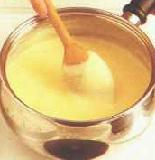 Custard is a family
of preparations based on milk and eggs, thickened with heat. Most
commonly, it refers to a dessert or dessert sauce, but custard bases are
also used for quiches and other savoury foods.
Custard is a family
of preparations based on milk and eggs, thickened with heat. Most
commonly, it refers to a dessert or dessert sauce, but custard bases are
also used for quiches and other savoury foods.
As a dessert, it is
made from a combination of milk or cream, egg yolks, sugar, and
flavourings such as vanilla. Sometimes flour, corn starch, or gelatin
are also added. In French cookery, custard—confusingly called just
crème—is never thickened in this way: when starch is added, it is pastry
cream crème pâtissière; when gelatin is added, it is crème anglaise
collée.
Depending on how
much egg or thickener is used, custard may vary in consistency from a
thin pouring sauce (crème anglaise), to a thick blancmange like that
used for vanilla slice or the pastry cream used to fill éclairs.
Custard is an
important part of dessert recipes from many countries, including the
United Kingdom, France, Portugal, Spain, Italy, and Australia.
Instant and
ready-made 'custards' are also marketed, though they are not true
custards if they are not thickened with egg.
Custard thickened
with starch is a non-Newtonian fluid which in short means that if
impacted with sufficient force it behaves more like a solid than a
liquid.
Method
For a basic dessert
custard, whisk 1/4 cup sugar with 4 egg yolks until pale yellow and
thick enough to form a slowly dissolving ribbon when lifted. Then add 1
1/2 cups cream that has been brought to a boil, very slowly and mixing
continually. Set over moderate heat (no more than 75 degrees Celsius),
and stir continually until it thickens.
Most custard is
cooked in a double boiler (bain-marie) or heated very gently on the
stove in a saucepan, but custard can also be steamed or baked in the
oven with or without a hot water bath.
Recipes
involving sweet custard include:
Bavarois
Bavarois is the French name for Bavarian cream, it is
a delicate cream dessert with a crème Anglaise base made from either
milk, cream or a fruit puree and then aerated with whipped cream and
whipped egg whites before being set in the refrigerator with gelatine.
It may be a straight vanilla or combined with additional flavourings;
such as chocolate, coffee or liqueurs, served on its own as an
individual dessert or as a filling for a variety of charlottes, tortes,
cakes etc.
Crème brûlée

Crème brûlée (French 'burnt cream') is a dessert
consisting of a rich custard base topped with a layer of hard caramel,
created by burning sugar under a salamander or other intense heat
source. It is usually served cold in individual ramekins. The custard
base is normally flavored with just vanilla, but it can be flavoured in
a number of ways, with chocolate, liqueur, fruit etc.
It is first attested in France, in Massialot's cookbook,
in 1691. The French name was used in the English translation of this
book, but in the early 18th century, it was called 'burnt cream' in
English.
In Britain, it is associated with Trinity College,
Cambridge, where it is called 'caramel cream' and where "the college
crest was impressed on top of the cream with a branding iron". It was
introduced to Trinity College in 1879, though some cookbooks claim a
much older origin.
In Catalonia, it is called crema catalana, and has a
custard base aromatised with lemon and cinnamon.
Crème caramel or Flan 
In cooking, crème caramel or flan is a kind of rich
custard dessert with a layer of soft caramel on top. Both names are of
French origin. The dish has spread across Europe and the world, and is
known as 'flan' in Spanish-speaking countries. In the United States, the
dish is now best-known in a Latin American context, so is called flan;
in Europe, it is generally known as crème caramel.
“In the latter part of the 20th century crème caramel
occupied an excessively large amount of territory in European restaurant
dessert menus. This was probably due to the convenience, for
restaurants, of being able to prepare a lot in advance and keep them
until needed.”
Crème caramel is a variant of plain custard (crème)
where some caramel syrup is poured into the mold before adding the
custard base. After the custard has set, it is turned out, leaving a
caramel sauce on top.
Under the name flan, the dessert is very popular in
Spain and in former Spanish colonies in Latin America and the
Philippines.
Like all custards, flan is made with whole eggs, milk or
cream, and sugar. The typical flavoring is simply vanilla, however,
there are numerous variations, including almond, pistachio, lemon, and
many types fruit.
In Argentina, and in some neighboring countries, flan is
usually eaten with Dulce de leche.
An imitation of flan may be prepared from instant flan
powder, which is thickened with agar rather than eggs; "Royal" is a
popular brand. In some Latin America countries, the true custard version
is known as "milk flan" (leche flan) or even "milk cheese", and the
substitute version is known as just "flan".
Flan is ubiquitous in Japanese convenience stores under
the name "custard pudding". It is not uncommon to find an entire shelf
in a Lawson or 7-Eleven dedicated to over a dozen brands and varieties
of flan.
Cream puff 
A cream puff is a dessert made from a filled choux
pastry (pâte à choux), a warm dough made with water, butter, flour and
eggs. The filling is typically whipped cream or custard. The eggs cause
the pastry to puff up into a hollow ball which can be filled by
injection or by slicing off the top of the pastry which is later
replaced. Cream puffs can be topped with powdered sugar, frosting,
fruit, or chocolate.
The cream puff originated in Italy, and is said to have
been created by Poelini, a chef to Catherine de Medici. It was then
brought over to France in the 16th century. It debuted at the Wisconsin
State Fair in 1924. In 2005, over 340,000 cream puffs were sold at the
fair, taking in a profit of over $1 million.
Currently, there is a growing appreciation of cream
puffs. Several companies in Japan have popularized the pastry, including
Choux Factory and Beard Papa.
A profiterole is a cream puff filled with ice cream and
typically topped with a chocolate sauce.
Custard tarts

A tart
is a pastry dish, usually sweet, similar to a pie, but different in that
the top is open and not covered with pastry. The tarte Tatin is a
particular kind of "upside-down" tart, of apples, other fruit, or onions.
Danish pastry

A
Danish pastry (or danish) is a sweet pastry which has become a
speciality of Denmark and is popular throughout the industrialized world,
although the form these pastries take is significantly different from
country to country. In the Scandinavian countries (including Denmark) it
is called wienerbrød/wienerbröd (Viennese bread) after the itinerant
Viennese bakers who brought their pastry skills to Scandinavia.
A
danish's ingredients are flour, milk, eggs, and generous amounts of
butter. The dough is rolled out thinly, coated with butter, and then
folded into numerous layers. If necessary, the dough is chilled to ease
handling. The rolling, buttering, folding, and chilling is repeated
several times to create a dough which is buttery and flaky.
The
danish varies from country to country, in USA various ingredients such
as jam, custard or cream cheese are placed on or within sections of
divided dough, which is then baked. Cardamom is often added to increase
the aromatic sense of sweetness.
The
real danish is topped by chocolate, sugar or icing, unstuffed or stuffed
with either jam or custard. Shapes are numerous, including circles,
figure-eights, snails, and the pretzel-like kringles.
In Denmark it is called "wienerbrød" Wich means
Wiener-bread, In Wien it is called "Kopenhagener Gebäck" wich means
"Copenhagen bread"
English trifle

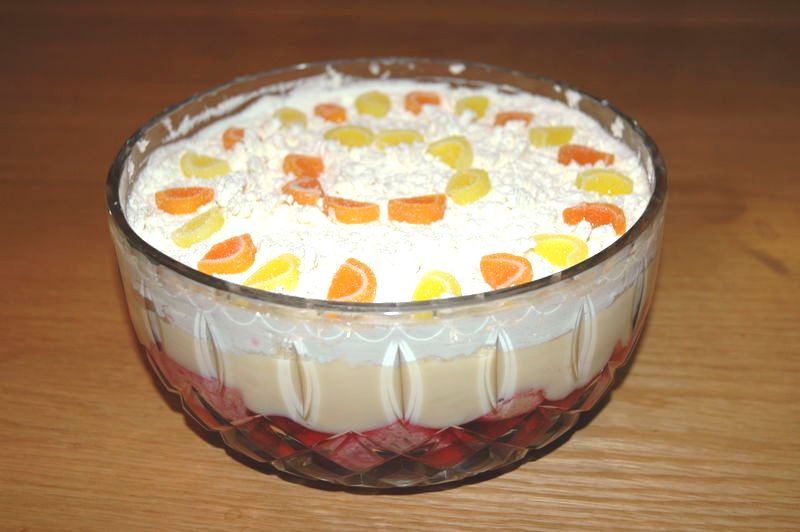 Trifle is English dessert dish made from thick (or often
solidified) custard, fruit, sponge cake, fruit juice or, more recently,
gelatin dessert and whipped cream, usually arranged in layers with fruit
and sponge on the bottom, custard and cream on top. Some trifles contain
a small amount of alcohol (port, or, most commonly sweet sherry or
madeira wine) - non-alcoholic versions use fruit juice instead, as the
liquid is necessary to moisten the cake. Trifle containing sherry is
sometimes called "Sherry Trifle" or referred to as being "High Church".
One popular variant has the sponges soaked in liquid-gelatin dessert
when the trifle is made, which sets when refrigerated. The cake and
jelly bind together and produce a uniquely pleasant texture if made in
the correct proportions (there should not be too much jelly added, or
nucleation will not occur).
Trifle is English dessert dish made from thick (or often
solidified) custard, fruit, sponge cake, fruit juice or, more recently,
gelatin dessert and whipped cream, usually arranged in layers with fruit
and sponge on the bottom, custard and cream on top. Some trifles contain
a small amount of alcohol (port, or, most commonly sweet sherry or
madeira wine) - non-alcoholic versions use fruit juice instead, as the
liquid is necessary to moisten the cake. Trifle containing sherry is
sometimes called "Sherry Trifle" or referred to as being "High Church".
One popular variant has the sponges soaked in liquid-gelatin dessert
when the trifle is made, which sets when refrigerated. The cake and
jelly bind together and produce a uniquely pleasant texture if made in
the correct proportions (there should not be too much jelly added, or
nucleation will not occur).
A well-made trifle is often used for decoration as well
as taste, incorporating the bright, layered colours of the fruit, jelly,
jam, and the contrast of the creamy yellow custard and white cream.
Trifles are often served at Christmas time, sometimes as
a lighter alternative to the massively dense christmas pudding.
A Creole trifle (also sometimes known as a Russian cake)
is a different but slightly related dessert item consisting of pieces of
a variety of cakes mixed together and packed firmly, moistened with
alcohol (commonly red wine or rum) and a sweet syrup or fruit juice, and
chilled. The resulting cake contains an arabesque of color and flavor.
Bakeries in New Orleans have been known to produce such cakes out of
their leftover or imperfect baked goods.
Egg tart 
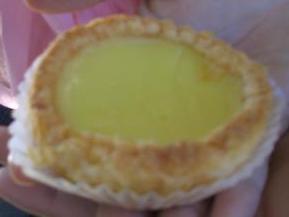 Egg
tart is a pastry found in Chinese cuisine. It consists of a flaky outer
crust, with a middle filled with egg custard, which is then baked. Egg
tarts are typically marketed at Chinese bakeries, cha chaan tengs (tea
restaurants), and some dim sum restaurants. The second character in the
Chinese name is a character that closely resembles 'tart' in
pronunciation (used only for its sound), while the first is Chinese for
'egg'.
Egg
tart is a pastry found in Chinese cuisine. It consists of a flaky outer
crust, with a middle filled with egg custard, which is then baked. Egg
tarts are typically marketed at Chinese bakeries, cha chaan tengs (tea
restaurants), and some dim sum restaurants. The second character in the
Chinese name is a character that closely resembles 'tart' in
pronunciation (used only for its sound), while the first is Chinese for
'egg'.
Today's
egg tarts come in many variations due to Hongkongers' eagerness to try
almost anything. These include egg white tarts, milk tarts, ginger
juice-flavored egg tarts (the two aforementioned variation was a take
upon traditional milk custard and egg custard, which was usually served
in cha chaan teng), chocolate tarts and even "birds' nest" tarts.
Frozen custard

Frozen
custard is a type of cold dessert similar to ice cream, made with eggs
in addition to cream and sugar. It typically contains 10% butterfat and
1.4% egg yolk.
It is
approximately 20% air by volume, called overrun. Ice cream will
typically have 100% overrun, which will cause the volume to double
because of the air, and also give it a coarser texture. A custard will
have a thick creamy texture compared to ice cream. Frozen custard must
be served at 26 degrees Fahrenheit, which is warmer than the 10 degrees
Fahrenheit in which ice cream is served.
Frozen
custard is generally prepared fresh at the place of sale, rather than
stored, however, it is occasionally available in supermarkets or by mail
order.
Frozen
custard originated in Coney Island, New York, by Archie C. Kohr. He
brought the first frozen custard machine there in 1919 and sold
approximately 18,000 cones during his first weekend there. During the
1933 World’s Fair, frozen custard was brought to Chicago. By the 1940s,
frozen custard stands could be found throughout the East and Midwest of
the United States.
Panna cotta 
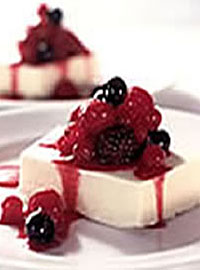 Panna
cotta is an Italian phrase, literally translating to "cooked cream".
Generally refers to a creamy, set Italian dessert from the Northern
Italian region of Piedmont. It is not generally known exactly how or
when this dessert came to be, but some theories estimate that cream (for
which this region is famous) was historically eaten plain or sweetened
with fruit. After years this treat evolved into what is now a
gelatin-thickened custard, flavored with vanilla, fruit, or spices and
served chilled.
Panna
cotta is an Italian phrase, literally translating to "cooked cream".
Generally refers to a creamy, set Italian dessert from the Northern
Italian region of Piedmont. It is not generally known exactly how or
when this dessert came to be, but some theories estimate that cream (for
which this region is famous) was historically eaten plain or sweetened
with fruit. After years this treat evolved into what is now a
gelatin-thickened custard, flavored with vanilla, fruit, or spices and
served chilled.
Basic panna cotta recipe
Allow the gelatin to dissolve in 1 Tbl of the cream
for about 5 minutes. Combine the remaining ingredients in a
medium saucepan over medium heat, stir occasionally until the sugar
dissolves and tiny bubbles appear around the edge of your pan, remove
from heat and add the gelatin, stir until it is thoroughly incorporated.
Pour the cream mixture into small ramekins (baking
dishes) and allow to set in the refrigerator for at least 4 hours, up to
overnight. Serve with fresh fruit, balsamic vinegar, port, or a
sweet sauce.
Pumpkin pie 
 Pumpkin pie is a traditional American and Canadian
dessert usually made in the late fall and early winter, especially for
Halloween, Thanksgiving, and Christmas.
Pumpkin pie is a traditional American and Canadian
dessert usually made in the late fall and early winter, especially for
Halloween, Thanksgiving, and Christmas.
The pie
consists of a squash-based custard, ranging in color from orange to
brown, baked in a single pie shell, rarely with a top crust. Contrary to
popular belief, traditional jack-o'-lantern-type pumpkins make poor
pies. The pie is generally flavored with nutmeg, cinnamon, cloves and
ginger and is traditionally served with whipped cream. Though some cooks
make this pie from scratch, it is more common to buy canned pumpkin pie
filling and follow the directions on the back of the can. Pumpkin pie is
a seasonal product available in bakeries and grocery stores.
The
holiday carol "There's No Place Like Home for the Holidays" makes a
reference to homemade pumpkin pie being looked forward to by a man
returning to his family's home in Pennsylvania
Vanilla slice 
Vanilla slice is a type of cake. It consists
of a thick custard sauce, which is traditionally flavoured with vanilla,
and which is sandwiched between flakey puff pastry or filo pastry and
iced with either vanilla or raspberry glaze.
It is
commonly sold in milk bars and cake shops in Australia and is often
referred to as a 'Snot Block' due to the consistency of the custard.
They
are also popular in the north of England.
It is
probably a version of the 'Napoleon' which may have originated in France
or Italy, though the filling is not always custard, and can be savoury
(such as spinach and cheese).
Zabaglione

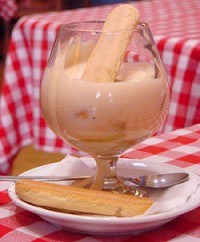 Zabaglione is an Italian dessert made with egg yolks,
sugar, a sweet liquor (usually Marsala wine), and sometimes cream or
whole eggs. It is a very light custard, which has been whipped to
incorporate a large amount of air. Zabaglione is traditionally served
with fresh figs and is sometimes also spelled sabayon, zabaione, or
zabajone. It is also popular in Argentina, where it is known as
sambayón.
Zabaglione is an Italian dessert made with egg yolks,
sugar, a sweet liquor (usually Marsala wine), and sometimes cream or
whole eggs. It is a very light custard, which has been whipped to
incorporate a large amount of air. Zabaglione is traditionally served
with fresh figs and is sometimes also spelled sabayon, zabaione, or
zabajone. It is also popular in Argentina, where it is known as
sambayón.
Zabaglione originated in Venice when this city ruled the
Adriatic. Originally, sweet Cyprus wine was used but with the retreat of
the Venetian Republic, Marsala wine began to be used instead. Another
change in the recipe is the use of sugar instead of honey, the original
ingredient. Classical zabaglione uses raw egg yolks but today many may
prefer to prepare it in a bain-marie. However, it is mainly recommended
to use a simple double boiler with a heat resistant bowl not reaching
the water and only simmer to avoid scrambling the eggs. Beaten egg white
is also widely replaced by whipped cream.
Vla 
Vla is
the name of two Dutch food products. One is a pie, called 'vla' in the
South, from whence it originates, but more commonly known as vlaai. The
other is a dairy product made from fresh milk which first appeared in
the 1950s. It has the viscosity of yoghurt or custard, but is sweet
rather than sour. It is served cold and is available in several flavors.